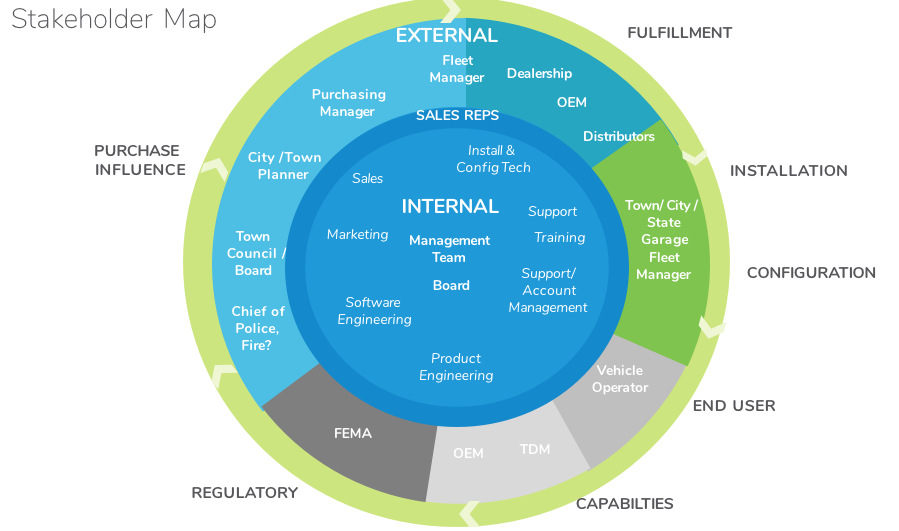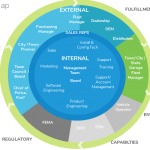What: Stakeholder Map
Influenced By: Interviews
Influences: Personas, Workflows, Journey Maps, Roadmap
At first mention, a stakeholder map will undoubtedly be one of the least exciting tools of Design Thinking and Service Design. However, its simplicity is what garners the conversations needed for Design Thinking success.
When was the last time you actually mapped your audience and influencers? I don’t mean just discussed them or considered them but actually mapped them for all of your teams to see, disagree, update, and refine? Such an exercise is extremely rare in organizations and one of the most useful places to begin when you want to consider customer-first, person-first, design strategy.
What is a Stakeholder Map?
A stakeholder map at its simplest definition will identify your customers, prospects, and audience.
- But who serves those individuals internally?
- Who is involved from outside influences such as manufacturers, advisors, board members, or others?
- Are there regulatory, safety or governing bodies that influence your services?
They’re all stakeholders too. While this information could sit in a spreadsheet, the simple exercise of visually mapping stakeholders, internal, external, and in-between, is a worthwhile exercise to get people thinking and talking. By visually depicting all stakeholders, and where they fall in relation to your organization, you take an important first step to understanding your overall experience, and touch points.
Influence
A stakeholder map comes from interviews within the organization and simply asking, “Who is involved in that?” as the multiple stages of customer and internal processes are involved. By conducting thorough, yet informal interviews, you can quickly identify the stakeholder landscape as a early project task from which everything else is informed.
The stakeholder map identifies all parties involved. As the project moves forward, your next step will be to narrow the focus with personas that include motivations, needs, blockers and opportunities for the highest priority stakeholders.
How to Identify Stakeholders
There are a few ways to look at stakeholders from their influence and involvement. They can be mapped in terms of new projects. Will they influence, review, and/or approve new plans? A simple table works well for this exercise. In this example a very fast exercise produced the internal and external stakeholders for a University as well as how the stakeholders would be involved in the project activities.

Stakeholder Lifecycle and Stages
Stakeholders can be reviewed from the purchase lifecycle or for more comprehensive view from the customer experience view from purchase all the way through to success planning such as the example below. You might note some stakeholders naturally cross over different stages, an important aspect of experience and planning.
This stakeholder map was designed for a manufacturing customer. To the company’s credit, they identified five stakeholders, mostly customer types of users for their software. When finished, together we had mapped out purchase influencers and decision makers, types of customers, event attendees, and even industry influencers. The result of this early exercise helped define how different personas should be represented in website content, event topics, training activities, marketing materials, social campaigns and how the product offering may be both simplified and targeted into different tiers of offerings.










